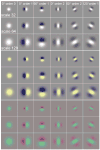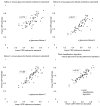Automated segmentation of the optic disc from stereo color photographs using physiologically plausible features
- PMID: 17389498
- PMCID: PMC2739577
- DOI: 10.1167/iovs.06-1081
Automated segmentation of the optic disc from stereo color photographs using physiologically plausible features
Abstract
Purpose: To evaluate a novel automated segmentation algorithm for cup-to-disc segmentation from stereo color photographs of patients with glaucoma for the measurement of glaucoma progression.
Methods: Stereo color photographs of the optic disc were obtained by using a fixed stereo-base fundus camera in 58 eyes of 58 patients with suspected or open-angle glaucoma. Manual planimetry was performed by three glaucoma faculty members to delineate a reference standard rim and cup segmentation of all stereo pairs and by three glaucoma fellows as well. Pixel feature classification was evaluated on the stereo pairs and corresponding reference standard, by using feature computation based on simulation of photoreceptor color opponency and visual cortex simple and complex cells. An optimal subset of 12 features was used to segment all pixels in all stereo pairs, and the percentage of pixels assigned the correct class and linear cup-to-disc ratio (LCDR) estimates of the glaucoma fellows and the algorithm were compared to the reference standard.
Results: The algorithm was able to assign cup, rim, and background correctly to 88% of all pixels. Correlations of the LCDR estimates of glaucoma fellows with those of the reference standard were 0.73 (95% CI, 0.58-0.83), 0.81 (95% CI, 0.70-0.89), and 0.86 (95% CI, 0.78-0.91), respectively, whereas the correlation of the algorithm with the reference standard was 0.93 (95% CI, 0.89-0.96; n = 58).
Conclusions: The pixel feature classification algorithm allows objective segmentation of the optic disc from conventional color stereo photographs automatically without human input. The performance of the disc segmentation and LCDR calculation of the algorithm was comparable to that of glaucoma fellows in training and is promising for objective evaluation of optic disc cupping.
Figures






References
-
- Tielsch JM, Sommer A, Katz J, Royall RM, Quigley HA, Javitt J. Racial variations in the prevalence of primary open-angle glaucoma. The Baltimore Eye Survey. JAMA. 1991;266:369–374. - PubMed
-
- Heijl A, Leske MC, Bengtsson B, Hyman L, Bengtsson B, Hussein M. Reduction of intraocular pressure and glaucoma progression: results from the Early Manifest Glaucoma Trial. Arch Ophthalmol. 2002;120:1268–1279. - PubMed
-
- Greaney MJ, Hoffman DC, Garway-Heath DF, Nakla M, Coleman AL, Caprioli J. Comparison of optic nerve imaging methods to distinguish normal eyes from those with glaucoma. Invest Ophthalmol Vis Sci. 2002;43:140–145. - PubMed
-
- Tielsch JM, Katz J, Quigley HA, Miller NR, Sommer A. Intraobserver and interobserver agreement in measurement of optic disc characteristics. Ophthalmology. 1988;95:350–356. - PubMed
-
- Panda DP, Rosenfeld A. Image Segmentation by Pixel Classification in (Grey Level, Edge Value) Space. IEEE Trans on Computers. 1978;27:875–879.
Publication types
MeSH terms
Grants and funding
LinkOut - more resources
Full Text Sources
Other Literature Sources
Medical

